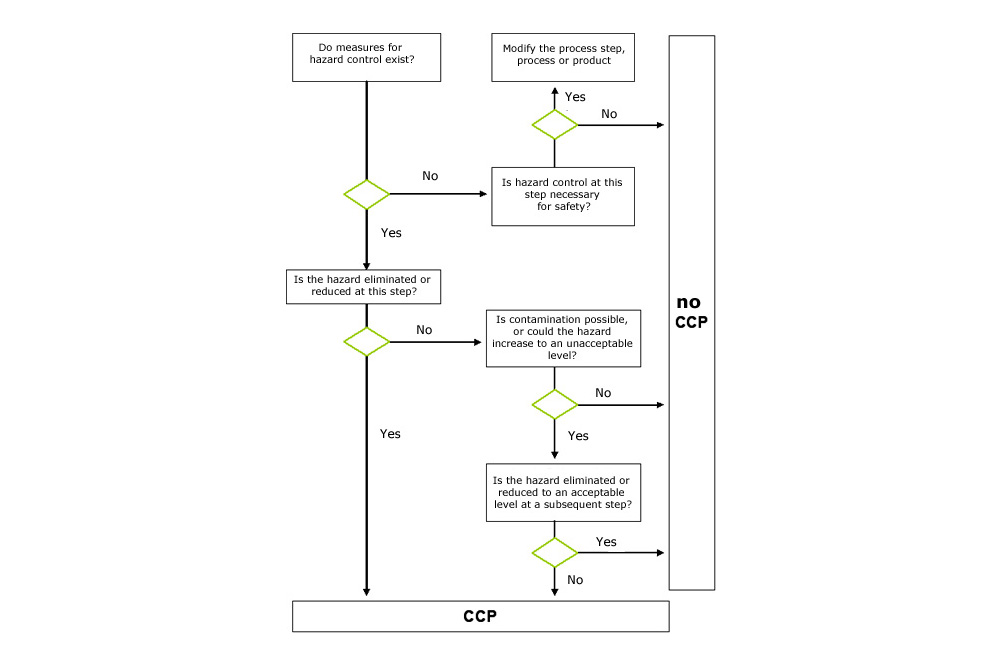

All the food people eat must be absolutely pure and clean. This is one of the most important imperatives in the food industry. One decisive criterion here is that your products leave your factory without any metal contaminations and other contaminants. The inspection of products for metallic contaminations has become an indispensable element of responsible food production, an inherent part of any HACCP concept (Hazard Analysis and Critical Control Points), and a prerequisite of successful IFS certification.
In a comprehensive and systematic HACCP concept it is not enough to
only inspect the final product for contaminations, because this means
that there still is danger due to contaminations in raw materials which
during processing are reduced to such small pieces that they can no
longer be reliably detected in a final inspection. To guarantee optimal
food safety, inspections must therefore be performed at various points
in the production process. The HACCP concept specifies that all the
points where missing inspection involves an unacceptable health risk for
consumers must be determined. These points in the production process
are referred to as CCPs (Critical Control Points).
For defining the proper CCPs and thus for achieving a safe HAACP
concept the potential hazards in the production process must first be
identified by way of a so-called hazard analysis.
In a hazard analysis all the physical, chemical, and biological hazards
that might possibly occur must be identified. Physical hazards for
example include the contamination of the product with metals, glass
splinters, bones, etc.
A risk assessment also must be performed, analysing on the one hand the
probability of contamination, and on the other hand the effects of such
contamination.
Summarising, the following questions should thus be answered in the hazard analysis:
Using a decision tree has proven to be a useful aid for identifying Critical Control Points:

Inspection systems such as e.g. metal detectors or X-ray scanners that detect and signal or automatically separate possible contaminations are used at the identified CCPs.
Once the Critical Control Points have been determined, specific limits are defined for each of these control points. Food safety only is guaranteed if these limits are observed. For the use of metal detectors or X-ray scanners these limits particularly refer to the scanning sensitivity, i.e. to the size of the detectable contamination, and to the corresponding signalling or eject devices.
Monitoring systems that monitor whether the defined limits are observed and indicate a possible loss of control are set up for each Critical Control Point. For metal detectors and X-ray systems this is done for example by way of test pieces that are used to check proper equipment function in regular intervals.
If the limits of a Critical Control Point are not observed, previously defined corrective measures must be taken.
The selection of your country allows us to offer the optimal content for you.
We have detected the following country based on your IP address:
If this is not correct, please choose your country below.
Aland Islands Albania Andorra Armenia Austria Aserbaidschan Belarus Belgium Bosnia-Herzegovina Bulgaria Croatia Cyprus Czech Republic Denmark Estonia Faroe Islands Finland France Georgia Germany Gibraltar Greece Guernsey Vatican City Hungary Iceland Ireland Isle of Man Italy Jersey Kazakhstan Kosovo Kyrgyzstan Lattvia Liechtenstein Lithuania Luxembourg Macedonia Malta Moldavia Monaco Montenegro Netherlands Norway Poland Portugal Romania Russia San Marino Serbia Slovakia Slovenia Spain Sweden Switzerland Tajikistan Turkey Turkmenistan Ukraina United Kingdom Uzbekistan
Anguilla Antigua & Barbuda Aruba Bahamas Barbados Belize Bermuda Canada Cayman Islands Costa Rica Cuba Curaçao Dominica Dominican Republic El Salvador Greenland Grenada Guadeloupe Guatemala Haiti Honduras Jamaica Martinique Mexico Montserrat Nicaragua Panamá Puerto Rico Saint Barthélemy Saint Kitts and Nevis Saint Lucia Saint Martin (French part) Saint Pierre and Miquelon Saint Vincent and the Grenadines Sint Maarten (Dutch part) Trinidad and Tobago Turks and Caicos Islands USA United States Virgin Islands British Virgin Islands Netherlands Antilles
Afghanistan Bahrain Bangladesh Bhutan British Indian Ocean Territory Cambodia China Taiwan India Indonesia Iran Iraq Israel Japan Jordan North Korea South Korea Kuwait Laos Lebanon Macao Malaysia Maldives Mongolia Myanmar Nepal Oman Pakistan Palestinian Territory, Occupied Philippines Qatar Saudi Arabia Singapore Sri Lanka Syria Taiwan Thailand Timor-Leste United Arab Emirates Vietnam Yemen
Algeria Angola Benin Botswana Burkina Faso Burundi Cameroon Cape Verde Central African Republic Chad Comoros Republic of the Congo Democratic Republic of the Congo Ivory Coast Djibouti Egypt Equatorial Guinea Eritrea Ethiopia Gabon Gambia Ghana Guinea Guinea-Bissau Kenya Lesotho Liberia Libya Madagascar Malawi Mali Morocco Mauritania Mauritius Mayotte Mozambique Namibia Niger Nigeria Reunion Rwanda Saint Helena, Ascension and Tristan da Cunha Sao Tome and Principe Senegal Seychelles Sierra Leone Somalia South Africa South Sudan Sudan Swaziland Tanzania Togo Tunesia Uganda Western Sahara Zambia Zimbabwe
American Samoa Australia Brunei Christmas Island Cocos (Keeling) Islands Cook Islands Fidschi French Polynesia Guam Heard Island and McDonald Islands Kiribati Marshall Islands Micronesia Nauru New Caledonia New Zealand Niue Norfolk Island Palau Papua New Guinea Pitcairn Samoa Solomon Islands Tokelau Tonga Tuvalu Vanuatu Wallis and Futuna Northern Mariana Islands